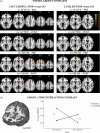Effects of fMRI neurofeedback of right inferior frontal cortex on inhibitory brain activation in children with ADHD
- PMID: 39428885
- PMCID: PMC11491852
- DOI: 10.1098/rstb.2023.0097
Effects of fMRI neurofeedback of right inferior frontal cortex on inhibitory brain activation in children with ADHD
Abstract
We aimed to replicate previous effects of functional magnetic resonance imaging neurofeedback (fMRI-NF) in right inferior frontal cortex (rIFC) on IFC activation during a Stop Task in a larger group of boys with attention-deficit/hyperactivity disorder (ADHD). The present double-blind, randomized controlled trial tested the effects of 15 runs of active versus sham fMRI-NF of rIFC on performance and activation associated with successful and failed inhibition versus Go trials during a tracking Stop task in 88 boys with ADHD (44 active; 44 sham), controlling for age and medication status. No significant group-by-time interaction effects were observed for performance or brain activation during the successful stop trials, and post hoc analysis showed very low numbers of active fMRI-NF learners. Nevertheless, during error monitoring, there was a significant group-by-time interaction effect on post-error reaction time slowing and in left IFC activation, which were both increased after active compared to sham fMRI-NF. The findings are in line with our previous observation of left IFC upregulation after fMRI-NF of rIFC relative to active fMRI-NF of parahippocampal gyrus. This highlights the potentially wider regional effects that fMRI-NF of a particular self-control target region has on other self-regulatory regions in ADHD. This article is part of the theme issue 'Neurofeedback: new territories and neurocognitive mechanisms of endogenous neuromodulation'.
Keywords: ADHD; children; fMRI neurofeedback; inhibition; stop-signal task.
Conflict of interest statement
Katya Rubia (KR) has received a grant from Takeda pharmaceuticals for another project and speaker’s bureau from Lundbeck and Supernus which were paid to KCL and used for research. The remaining authors declare that the research was conducted in the absence of any commercial or financial relationships that could be construed as a potential conflict of interest.
Figures



References
-
- American Psychiatric Association . 2013. Diagnostic and statistical manual of mental disorders: DSM-5, 5th edn. Washington, DC: APA.
Publication types
MeSH terms
Grants and funding
LinkOut - more resources
Full Text Sources
Medical
